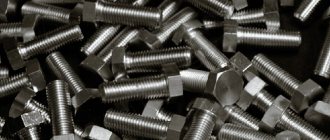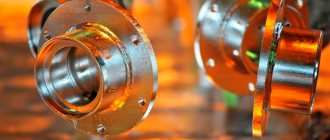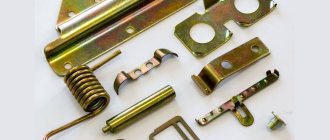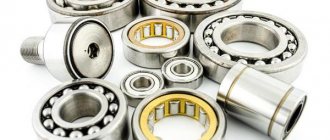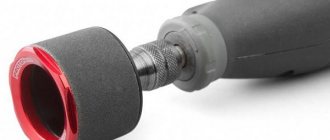Painting is the best way to aesthetically decorate stainless steel surfaces and products. In addition, applying a layer of paint becomes a strong anti-corrosion protection for the metal, especially during prolonged exposure to the open air. Powder painting is the most modern and reliable method of painting stainless steel.
This is due to the low level of adhesion of steel to liquid paint compositions. Traditional painting methods in this case demonstrate high labor intensity and insufficient reliability of the applied coating. Powder paint adheres well to metal, holds firmly, and has a long service life.
Powder coating has the ability to provide perfectly smooth and uniform coloring. It does not flow, does not bubble, and does not form lumps. High-quality powder paints are resistant to water and temperature changes, do not chip, do not fade under the sun and can last up to 30 years.
Carbon steel.
Carbon steel is one of the main types of structural materials in modern industry; it is an alloy of iron, carbon and a relatively small amount of alloying additives. Iron does not passivate in air (unlike other metals of its subgroup, such as nickel), so its main disadvantage is its low corrosion resistance. During corrosion, iron combines with oxygen and turns into oxides FeO, Fe2O3 and Fe3O4, covering the steel with a porous layer that is completely permeable to the external environment. This layer does not in any way prevent further destruction of the metal. The process of steel corrosion does not spontaneously die out and can last for years until the products are completely destroyed. Therefore, steel without coating, electrochemical protection or alloying with nickel and chromium should not be used either in atmospheric conditions or in aggressive environments. Most often, galvanic galvanizing and chemical phosphating (with oiling or chromating) are used to protect steel from corrosion.
Advantages:
- Low cost;
- Good weldability;
- Relatively high hardness;
- Resistance to dynamic loads;
- No temper brittleness.
Flaws:
- Low atmospheric corrosion resistance;
- Susceptible to severe embrittlement at low temperatures.
Painting Tips
- Work must be carried out at positive temperatures from 5 to 35 degrees with air humidity not exceeding 80 percent;
- It is necessary to paint only with a spray bottle. Standard tools such as a roller and brush are not suitable for this process. Using this tool, paint the surface in a straight line. In this case, each new line should partially overlap the previously drawn one. Try to work quickly so that the paint hardens more or less simultaneously. Hold the spray bottle at a 90 degree angle to the surface at a distance of approximately 0.2 meters;
- Before placing the paint in the spray bottle, the solution must be stirred well to achieve complete homogeneity;
- The surface must be painted in at least two layers. In some cases, the paint is applied three times. At the same time, it is necessary to carry out work on applying the next layer only when the previous one has dried;
- After painting the surface, it can be varnished to protect it from external influences. For these actions, you can use a clear varnish designed for yachts.
Stainless steel.
Stainless steel is an alloy of iron and carbon, predominantly alloyed with large amounts of chromium and nickel. From the name of this structural material it is clear that it is mainly used in environments that cause active corrosion of ordinary steel. Thus, stainless steel is stable in industrial atmospheres and water, and resists the effects of sulfuric acid well. At the same time, stainless steel is difficult to solder, has a fairly low coefficient of friction, conducts electricity poorly, and is resistant to alkalis (unlike carbon steel) due to the presence of chromium in it. However, all these disadvantages are effectively eliminated by electroplating.
The difficulty of coating stainless steel is associated with the presence on the surface of the parts of a thin, durable passive film of chromium and nickel oxides, which does not allow the coating to adhere well to the base after conventional preparation technology. This film is easily etched off, but almost instantly forms again in air. Therefore, for galvanizing stainless steel, more complex methods are used than for processing conventional steel.
Using such methods, stainless steel can be chrome-plated, tin-plated, nickel-plated, copper-plated, etc. Nickel is used to enhance the shine of complex-profile surfaces instead of mechanical or electrochemical polishing. Also, thanks to nickel, stainless steel parts are completely protected from the effects of alkalis. Chrome increases wear and heat resistance. To protect against the appearance of a corrosive galvanic couple when paired with aluminum, a tin-bismuth alloy is used. Copper imparts spark-proof properties, facilitates make-up, protects against scuffing and increases electrical conductivity. The black zinc coating is decorative. The overall corrosion resistance of stainless steel can be improved by chemical passivation.
Advantages:
- High atmospheric corrosion resistance;
- Stability in a mixture of strong acids containing several percent HNO3, but in the absence of HCl and HF;
- Stability at 300° C in H2O, HNO3 and organic acids;
- Acceptable weldability.
Flaws:
- High price;
- Increased fragility in weld areas.
Difficulties in painting stainless steel
Powder coating of stainless steel is a method that meets the characteristics of the surface being treated. Smooth steel rejects the approach of using conventional liquid paints and varnishes, since the latter simply do not adhere to it. The adhesion of stainless steel is low, which adds to the complexity of painting. The solution to the problem is the choice of an adequate coloring composition and adherence to technology. At home, painting stainless steel with powder is difficult. Additional equipment will be required, namely an installation for imparting a charge to paint particles, a spray gun, and an oven for polymerizing the paint composition. It is commercially available, but if you have the skills and experience, you can make it yourself. Powder coating is a technology most often used in industrial settings.
Powder painting
3. Cast iron.
Cast iron is an alloy of iron with a large amount of carbon (at least 2.14%). Carbon imparts hardness but reduces ductility. Depending on the form of graphite and the amount of cementite, white, gray, malleable and high-strength cast iron are distinguished. As a rule, products are made from cast iron by casting. The difficulty in coating cast iron lies in the presence of a casting crust, if it is damaged, it is not possible to obtain a high-quality coating. In addition, due to the high carburization of cast iron, during etching, a lot of iron carbides appear on its surface in the form of powder, making it difficult to obtain a firmly bonded coating. Galvanizing cast iron from alkaline solutions is difficult due to the predominant release of hydrogen rather than zinc.
Areas of use
Satin-finished stainless steel has a satin-like appearance. Such items look stylish, elegant and expensive. Such things are easy to care for and retain their attractive appearance for a long time. Satin steel is used to create:
- interior items and lamps;
- dishes and cutlery;
- furniture elements;
- stairs, railings and partitions;
- plumbers;
- parts for process equipment, etc.
Elements made of satin steel are perfect for interior design in a minimalist or hi-tech style. It does not go well with wood and textiles made from natural fabrics.
Copper and its alloys.
Copper is a non-ferrous metal with a wide range of applications. Various alloys are produced from copper, such as brass (copper + zinc) or bronze (copper + tin). Copper has high electrical and thermal conductivity and good corrosion resistance in many environments. Coating of copper and its alloys is carried out for protective, decorative and special purposes (improving solderability, protection against oxidation, stabilization of contact resistance). Typical platings are nickel, tin-bismuth and silver. Tin-lead coating is less commonly used. Today, a tin-nickel alloy is considered promising, which has all the advantages of other tin-based alloys, but is characterized by high hardness, ductility and wear resistance. This alloy is increasingly used in Europe. Depending on the grade of copper or its alloy (brass, bronze, cupronickel, nickel silver, kunial (M, L, Br, MN, etc.)), the surface preparation technology before coating changes.
Aluminum and its alloys.
Aluminum is one of the main types of structural materials, widely used in electrical engineering, instrumentation, mechanical engineering and aircraft construction. Aluminum is lightweight and corrosion-resistant in the atmosphere due to the thinnest passive film of several nanometers present on its surface. Aluminum conducts electricity and heat well. The price of aluminum is lower than other non-ferrous metals, and natural reserves are huge. However, aluminum also has a number of disadvantages. It solders worse than tin, does not have wear resistance, and is almost impossible to polish to a mirror shine. In a salt environment, alkalis, hydrochloric acid and a number of other reagents, aluminum actively corrodes. When in contact with copper parts or stainless steel, aluminum forms a corrosive galvanic couple. Therefore, the surface of aluminum often needs to be modified by galvanic or chemical coatings.
Among the coatings on aluminum, two groups can be distinguished: oxide and metal. Chemical and anodic oxidation of aluminum does not present any great difficulties with established production technology. At the same time, the application of metal coatings requires serious surface preparation and the mandatory application of one or two technological sublayers. This is due (as with stainless steel or titanium) to aluminum's ability to passivate almost instantly. The passive film is easily restored to a wet part after etching and prevents further adhesion of the coating and the substrate. Moreover, if aluminum is poorly prepared after metallization, hidden defects may form and the coating may “bubble” during storage even after several months or during soldering. For this reason, all metal coatings on aluminum must be tested for adhesion in 100% of cases by at least two methods according to GOST.
The division of aluminum alloys into wrought and cast alloys is due to the peculiarities of molding semi-finished and finished products from them.
Wrought aluminum alloys are intended primarily for subsequent turning, milling, extrusion, etc. They differ in composition from foundry ones in the absence or insignificant content of silicon in them. When etching deformable alloys, a sludge of alloying additives and intermetallic compounds is formed on their surface, which, during the subsequent mandatory clarification operation, is easily removed with ordinary nitric acid and does not interfere with the coating. During the anodizing process, such sludge dissolves in the electrolyte and also does not accumulate on the surface. The presence of silicon in the aluminum alloy (and, as a consequence, in the etching sludge) would make the processes of oxidation and metallization of aluminum much more complex. Thus, coating of wrought aluminum alloys is easier than that of cast aluminum alloys.
Cast aluminum alloys are one of the main structural materials widely used in electrical engineering, instrumentation and aircraft manufacturing. Cast aluminum alloys are characterized by a high silicon content, which is associated with high complexity in preparing their surface before coating. Any coating of cast aluminum is a complex process due to the presence of an oxide film on its surface and the formation of silicon powder on the surface during etching. All this prevents strong adhesion of the coating to the base. This problem is solved by using special preliminary preparation operations.
Recommendations for work
- The temperature is maintained at 5-35 degrees; humidity no more than 80%.
- You cannot use ordinary tools (brush, roller) when painting. The work uses a spray gun. Hand movements go in a straight line, each subsequent strip of paint partially overlaps the previous one. The dye is sprayed quickly so that it hardens evenly. The tool is located at a distance of 20 cm from the surface and at a right angle.
- Before starting to paint stainless steel, the paintwork material is thoroughly mixed until smooth. After this, the spray bottle is charged with liquid composition.
- Apply 2 layers of paint. Before painting the stainless steel with a second layer, you need to wait until the first layer has dried.
- To enhance resistance to external influences, the painted surface is coated with transparent yacht varnish.
Important : the paint coating will last a long time if the top layer of steel is cleaned without defects. Otherwise the coating will come off.
We recommend videos on the topic:
Titanium and its alloys.
Titanium is the most important structural material with a number of unique properties. Titanium is light, which is due to its low density (4540 kg/m3). It is almost 2 times lighter than iron, although it is inferior in this indicator to aluminum by the same amount. Along with being lightweight, titanium is highly durable. Unique is titanium’s ability to passivate and, as a result, its exceptional corrosion resistance. Industrial gases, salt water and oxidizing agents do not cause any harm to titanium. However, despite all the positive qualities, titanium is expensive, difficult to process and mold, and has a high coefficient of friction. Soldering and welding titanium is complex and time-consuming. It is 24 times worse at conducting electricity than copper, 16 times worse than aluminum and 4 times worse than steel. Titanium is inferior in thermal conductivity to aluminum by almost 15 times, and steel by 5 times. In terms of thermal conductivity, titanium is also 15 times worse than aluminum, and steel by 3.5 times. At high temperatures, titanium actively interacts with oxygen, nitrogen, carbon, halogens (chlorine, bromine, iodine, fluorine), as well as sulfur. Even at room temperature, titanium is unstable in alkalis and hydrogen peroxide.
The application of protective and decorative galvanic coatings on titanium can improve many of its properties and eliminate its shortcomings. Chrome plating of titanium increases its wear resistance and heat resistance. To increase the electrical conductivity and solderability of titanium, tin plating (tin-bismuth), copper plating and silver plating are used. Anti-friction properties are improved when coated with tin-lead and lead. Nickel and nickel-phosphorus alloy (chemical nickel) protect titanium from the effects of alkalis at any concentration and temperature. The appearance of titanium is enhanced by shiny chrome, nickel and tin-bismuth coatings. Anodic oxidation is often used for decorative finishing of titanium. In this case, unlike colorless translucent oxides on aluminum, a colored film is formed on titanium. Its color depends on the voltage applied to the part, which can reach up to 120 V. Anodizing can be used to paint titanium in light green, dark gray, blue, black, gold and other colors.
Applying metal coatings to titanium requires a lot of experience and presents significant challenges. Due to the ability to passivate almost instantly, titanium always has a layer of oxides on its surface, which sharply impairs the adhesion of coatings. In addition, hydrogen easily diffuses into titanium during surface preparation. Accumulating at the base/coating interface, it will also cause peeling and deteriorate the physical and mechanical properties of the part.
Zinc-aluminum-copper alloys (ZAM).
TsAM is an alloy of zinc with aluminum and copper. This material pours easily and with high precision. A special feature of the coating of this material is the presence of a cast crust and hidden micropores on its surface. In view of this, there is a great danger of “bubbles” appearing on the coating. In addition, zinc alloy perfectly absorbs hydrogen generated during galvanic operations. Hydrogen is sorbed during coating and partially desorbed during storage. However, it can also contribute to the formation of “bubbles”. To obtain a high-quality coating that is firmly adhered to the surface of the CAM, it is necessary to use specialized technologies.
